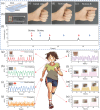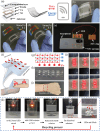Microconfined Assembly of High-Resolution and Mechanically Robust EGaIn Liquid Metal Stretchable Electrodes for Wearable Electronic Systems
- PMID: 38898769
- PMCID: PMC11425843
- DOI: 10.1002/advs.202402818
Microconfined Assembly of High-Resolution and Mechanically Robust EGaIn Liquid Metal Stretchable Electrodes for Wearable Electronic Systems
Abstract
Stretchable electrodes based on liquid metals (LM) are widely used in human-machine interfacing, wearable bioelectronics, and other emerging technologies. However, realizing the high-precision patterning and mechanical stability remains challenging due to the poor wettability of LM. Herein, a method is reported to fabricate LM-based multilayer solid-liquid electrodes (m-SLE) utilizing electrohydrodynamic (EHD) printed confinement template. In these electrodes, LM self-assembled onto these high-resolution templates, assisted by selective wetting on the electrodeposited Cu layer. This study shows that a m-SLE composed of PDMS/Ag/Cu/EGaIn exhibits line width of ≈20 µm, stretchability of ≈100%, mechanical stability ≈10 000 times (stretch/relaxation cycles), and recyclability. The multi-layer structure of m-SLE enables the adjustability of strain sensing, in which the strain-sensitive Ag part can be used for non-distributed detection in human health monitoring and the strain-insensitive EGaIn part can be used as interconnects. In addition, this study demonstrates that near field communication (NFC) devices and multilayer displays integrated by m-SLEs exhibit stable wireless signal transmission capability and stretchability, suggesting its applicability in creating highly-integrated, large-scale commercial, and recyclable wearable electronics.
Keywords: electrodeposition; electrohydrodynamic printing; flexible electronics; liquid metal; multilayer circuits.
© 2024 The Author(s). Advanced Science published by Wiley‐VCH GmbH.
Conflict of interest statement
The authors declare no conflict of interest.
Figures






References
-
- Li M., Zhang Y., Lian L., Liu K., Lu M., Chen Y., Zhang L., Zhang X., Wan P., Adv. Funct. Mater. 2022, 32, 2208141.
-
- Choi H. J., Ahn J., Jung B. K., Choi Y. K., Park T., Bang J., Park J., Yang Y., Son G., Oh S. J., ACS Appl. Mater. Interfaces 2023, 15, 42836. - PubMed
-
- Park S., Heo S. W., Lee W., Inoue D., Jiang Z., Yu K., Jinno H., Hashizume D., Sekino M., Yokota T., Fukuda K., Tajima K., Someya T., Nature 2018, 561, 516. - PubMed
Grants and funding
LinkOut - more resources
Full Text Sources
